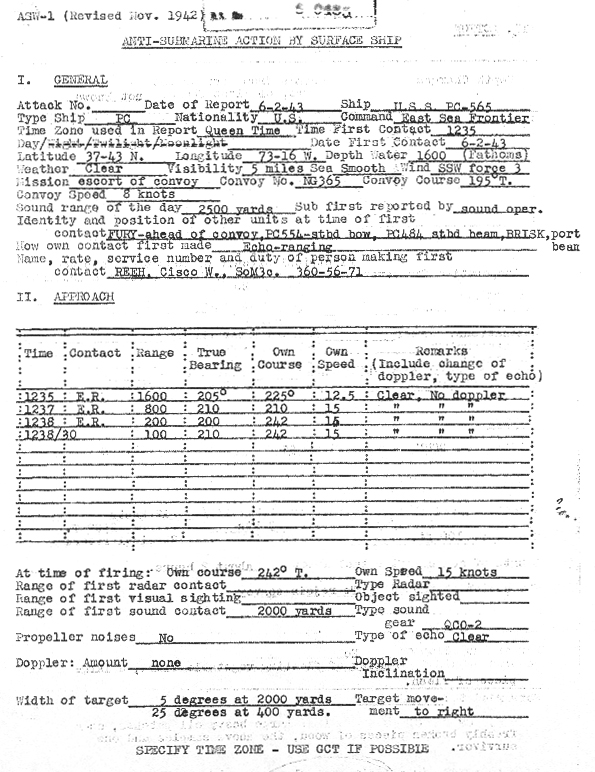
| At about 1235 Queen, June 2, 1943, in DR Lat. 37-43N, Long. 73-16W, as escort of convoy, we were patrolling at about 12.5 knots, on course 2250T, the right leg of our patrol, when contact was reported bearing 2050T, range 1600 yards. At 1236Q, the crew went to general quarters and course was altered to 2050T. Two cut-ons were given as 1950T and 2050T. The chemical recorder was cut in at about 1000 yards and speed was increased to 15 knots at about 800 yards. Between 1000 and 800 yards the target bearing changed slowly to the right and course was altered to 2150T. The range rate was reported at 12 knots bearings continued to change slowly to the right until at 350 yards range the right cut-on was 2250 and our course 2420T. We held contact to 100 yards and bearings dropped slowly aft until at time of losing contact the bearing was 2000T. | ||
| Since the target was in a good position to attack the convoy it was assumed that he was close to periscope depth and all charges were set at 100 feet. | ||
| At 1239 Queen a standard five charge pattern was dropped. | ||
| We continued on course 2420T for two minutes or until we were 1000 yards from point of attack. At that time we turned to the right with full rudder and slowed to 2/3 speed (about 12.5 knots) to facilitate sound search. While turning, large air bubbles were seen rising at about the position of the attack and the conning tower broke the surface. We immediately went | ||
| to full speed intending to ram. Heavy smoke from exhausts prevented the #2 gun crew opening fire. The #1 gun misfired, but the Starboard 20MM opened fire and fired 55 rounds scoring several hits on the tower. | ||
| The tower appeared large and seemed to be well out of the water nevertheless the decks and guns did not appear above water. When about 400 yards from the sub it began to sink and since we could no longer ram, course was altered to the right to pass ahead of swirl. One depth charge, set at 100 feet, was dropped about 100 yards ahead of estimated position of submarine at 1243Q. The projectors had not been reloaded. While on the surface the submarine seemed to be on course between 2000T and 1500T, and may have been turning left. The ship was conned by sight during this attack and the ship’s course at time of dropping is uncertain but believed to be about 1000T. | ||
| We immediately slowed to 2/3 speed and attempted to regain contact. We were unsuccessful and believed that the sub had sunk. We headed toward a survivor in the water at spot where sub had submerged and had stopped the engines to pick him up. While we were coasting, a sound contact was reported on port bow at about 300 yards range, but it was immediately lost. At the same time a large air bubble appeared at that spot (about 1250Q). We immediately went to standard speed and headed for that spot but contact was not regained. We picked up the survivor and continued search. Contact was not regained although we searched the area in every direction to a distance of about 4000 yards. At | ||
| 1325 we returned to the area marked by a heavy oil slick in two places – believed to be at the position of our two attacks. One slick was dark with globules of what seemed to be dark brown oil but the slick was not iridescent. The second was larger and the oil did not seem to be as well mixed with the water as the first. The oil lay in heavy patches on the surface and was iridescent, while the smell of oil was extremely strong. Some patches of vegetable fiber were floating and a sample was obtained. A few splinters of freshly broken wood were observed. At 1338 picked up a large piece of flesh. Continued to search area until 1430Q and rejoined convoy at 1635Q. | ||
| When misfire was cleared by unloading shell from #1 gun the primer was dented in at least five places by blows of the striker. When the action was over, a #3” ammunition in the ready boxes was replaced by ammunition from the magazines. The delay in loading the projectors was due to some disorganization at those stations. Most of the men had been aboard for only a few days, they had had no experience and were imperfectly drilled. Due to the heavy smoke and excitement they became confused long enough to make the projectors unavailable for the second attack. | ||
| The survivor, Lieut. Comdr. Klaus Bargsten, states that he was C.O. of the submarine, the U-521, that he was on course 2500 at the time the charges exploded, that he did not hear our echo-ranging or screws until we were almost over him, that he gave the order to abandon ship but that water poured down the hatch before anyone else could get out and that the submarine sank with the hatch open. | ||